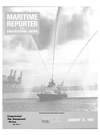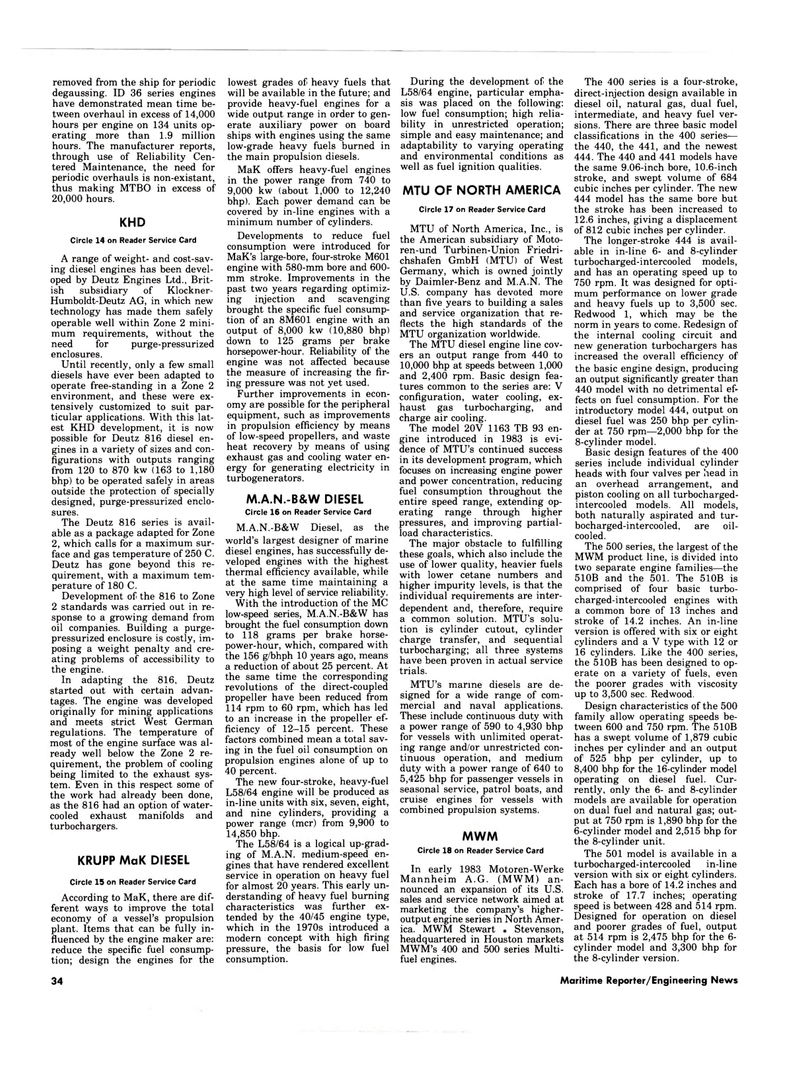
Page 32: of Maritime Reporter Magazine (January 15, 1985)
Read this page in Pdf, Flash or Html5 edition of January 15, 1985 Maritime Reporter Magazine
removed from the ship for periodic degaussing. ID 36 series engines have demonstrated mean time be- tween overhaul in excess of 14,000 hours per engine on 134 units op- erating more than 1.9 million hours. The manufacturer reports, through use of Reliability Cen- tered Maintenance, the need for periodic overhauls is non-existant, thus making MTBO in excess of 20,000 hours.
KHD
Circle 14 on Reader Service Card
A range of weight- and cost-sav- ing diesel engines has been devel- oped by Deutz Engines Ltd., Brit- ish subsidiary of Klockner-
Humboldt-Deutz AG, in which new technology has made them safely operable well within Zone 2 mini- mum requirements, without the need for purge-pressurized enclosures.
Until recently, only a few small diesels have ever been adapted to operate free-standing in a Zone 2 environment, and these were ex- tensively customized to suit par- ticular applications. With this lat- est KHD development, it is now possible for Deutz 816 diesel en- gines in a variety of sizes and con- figurations with outputs ranging from 120 to 870 kw (163 to 1,180 bhp) to be operated safely in areas outside the protection of specially designed, purge-pressurized enclo- sures.
The Deutz 816 series is avail- able as a package adapted for Zone 2, which calls for a maximum sur- face and gas temperature of 250 C.
Deutz has gone beyond this re- quirement, with a maximum tem- perature of 180 C.
Development of the 816 to Zone 2 standards was carried out in re- sponse to a growing demand from oil companies. Building a purge- pressurized enclosure is costly, im- posing a weight penalty and cre- ating problems of accessibility to the engine.
In adapting the 816, Deutz started out with certain advan- tages. The engine was developed originally for mining applications and meets strict West German regulations. The temperature of most of the engine surface was al- ready well below the Zone 2 re- quirement, the problem of cooling being limited to the exhaust sys- tem. Even in this respect some of the work had already been done, as the 816 had an option of water- cooled exhaust manifolds and turbochargers.
KRUPP MaK DIESEL
Circle 15 on Reader Service Card
According to MaK, there are dif- ferent ways to improve the total economy of a vessel's propulsion plant. Items that can be fully in- fluenced by the engine maker are: reduce the specific fuel consump- tion; design the engines for the lowest grades of heavy fuels that will be available in the future; and provide heavy-fuel engines for a wide output range in order to gen- erate auxiliary power on board ships with engines using the same low-grade heavy fuels burned in the main propulsion diesels.
MaK offers heavy-fuel engines in the power range from 740 to 9,000 kw (about 1,000 to 12,240 bhp). Each power demand can be covered by in-line engines with a minimum number of cylinders.
Developments to reduce fuel consumption were introduced for
MaK's large-bore, four-stroke M601 engine with 580-mm bore and 600- mm stroke. Improvements in the past two years regarding optimiz- ing injection and scavenging brought the specific fuel consump- tion of an 8M601 engine with an output of 8,000 kw (10,880 bhp) down to 125 grams per brake horsepower-hour. Reliability of the engine was not affected because the measure of increasing the fir- ing pressure was not yet used.
Further improvements in econ- omy are possible for the peripheral equipment, such as improvements in propulsion efficiency by means of low-speed propellers, and waste heat recovery by means of using exhaust gas and cooling water en- ergy for generating electricity in turbogenerators.
M.A.N.-B&W DIESEL
Circle 16 on Reader Service Card
M.A.N.-B&W Diesel, as the world's largest designer of marine diesel engines, has successfully de- veloped engines with the highest thermal efficiency available, while at the same time maintaining a very high level of service reliability.
With the introduction of the MC low-speed series, M.A.N.-B&W has brought the fuel consumption down to 118 grams per brake horse- power-hour, which, compared with the 156 g/bhph 10 years ago, means a reduction of about 25 percent. At the same time the corresponding revolutions of the direct-coupled propeller have been reduced from 114 rpm to 60 rpm, which has led to an increase in the propeller ef- ficiency of 12-15 percent. These factors combined mean a total sav- ing in the fuel oil consumption on propulsion engines alone of up to 40 percent.
The new four-stroke, heavy-fuel
L58/64 engine will be produced as in-line units with six, seven, eight, and nine cylinders, providing a power range (mcr) from 9,900 to 14,850 bhp.
The L58/64 is a logical up-grad- ing of M.A.N, medium-speed en- gines that have rendered excellent service in operation on heavy fuel for almost 20 years. This early un- derstanding of heavy fuel burning characteristics was further ex- tended by the 40/45 engine type, which in the 1970s introduced a modern concept with high firing pressure, the basis for low fuel consumption.
During the development of the
L58/64 engine, particular empha- sis was placed on the following: low fuel consumption; high relia- bility in unrestricted operation; simple and easy maintenance; and adaptability to varying operating and environmental conditions as well as fuel ignition qualities.
MTU OF NORTH AMERICA
Circle 17 on Reader Service Card
MTU of North America, Inc., is the American subsidiary of Moto- ren-und Turbinen-Union Friedri- chshafen GmbH (MTU) of West
Germany, which is owned jointly by Daimler-Benz and M.A.N. The
U.S. company has devoted more than five years to building a sales and service organization that re- flects the high standards of the
MTU organization worldwide.
The MTU diesel engine line cov- ers an output range from 440 to 10,000 bhp at speeds between 1,000 and 2,400 rpm. Basic design fea- tures common to the series are: V configuration, water cooling, ex- haust gas turbocharging, and charge air cooling.
The model 20V 1163 TB 93 en- gine introduced in 1983 is evi- dence of MTU's continued success in its development program, which focuses on increasing engine power and power concentration, reducing fuel consumption throughout the entire speed range, extending op- erating range through higher pressures, and improving partial- load characteristics.
The major obstacle to fulfilling these goals, which also include the use of lower quality, heavier fuels with lower cetane numbers and higher impurity levels, is that the individual requirements are inter- dependent and, therefore, require a common solution. MTU's solu- tion is cylinder cutout, cylinder charge transfer, and sequential turbocharging; all three systems have been proven in actual service trials.
MTU's marine diesels are de- signed for a wide range of com- mercial and naval applications.
These include continuous duty with a power range of 590 to 4,930 bhp for vessels with unlimited operat- ing range and/or unrestricted con- tinuous operation, and medium duty with a power range of 640 to 5,425 bhp for passenger vessels in seasonal service, patrol boats, and cruise engines for vessels with combined propulsion systems.
MWM
Circle 18 on Reader Service Card
In early 1983 Motoren-Werke
Mannheim A.G. (MWM) an- nounced an expansion of its U.S. sales and service network aimed at marketing the company's higher- output engine series in North Amer- ica. MWM Stewart * Stevenson, headquartered in Houston markets
MWM's 400 and 500 series Multi- fuel engines.
The 400 series is a four-stroke, direct-injection design available in diesel oil, natural gas, dual fuel, intermediate, and heavy fuel ver- sions. There are three basic model classifications in the 400 series— the 440, the 441, and the newest 444. The 440 and 441 models have the same 9.06-inch bore, 10.6-inch stroke, and swept volume of 684 cubic inches per cylinder. The new 444 model has the same bore but the stroke has been increased to 12.6 inches, giving a displacement of 812 cubic inches per cylinder.
The longer-stroke 444 is avail- able in in-line 6- and 8-cylinder turbocharged-intercooled models, and has an operating speed up to 750 rpm. It was designed for opti- mum performance on lower grade and heavy fuels up to 3,500 sec.
Redwood 1, which may be the norm in years to come. Redesign of the internal cooling circuit and new generation turbochargers has increased the overall efficiency of the basic engine design, producing an output significantly greater than 440 model with no detrimental ef- fects on fuel consumption. For the introductory model 444, output on diesel fuel was 250 bhp per cylin- der at 750 rpm—2,000 bhp for the 8-cylinder model.
Basic design features of the 400 series include individual cylinder heads with four valves per head in an overhead arrangement, and piston cooling on all turbocharged- intercooled models. All models, both naturally aspirated and tur- bocharged-intercooled, are oil- cooled.
The 500 series, the largest of the
MWM product line, is divided into two separate engine families—the 510B and the 501. The 510B is comprised of four basic turbo- charged-intercooled engines with a common bore of 13 inches and stroke of 14.2 inches. An in-line version is offered with six or eight cylinders and a V type with 12 or 16 cylinders. Like tbe 400 series, the 510B has been designed to op- erate on a variety of fuels, even the poorer grades with viscosity up to 3,500 sec. Redwood.
Design characteristics of the 500 family allow operating speeds be- tween 600 and 750 rpm. The 510B has a swept volume of 1,879 cubic inches per cylinder and an output of 525 bhp per cylinder, up to 8,400 bhp for the 16-cylinder model operating on diesel fuel. Cur- rently, only the 6- and 8-cylinder models are available for operation on dual fuel and natural gas; out- put at 750 rpm is 1,890 bhp for the 6-cylinder model and 2,515 bhp for the 8-cylinder unit.
The 501 model is available in a turbocharged-intercooled in-line version with six or eight cylinders.
Each has a bore of 14.2 inches and stroke of 17.7 inches; operating speed is between 428 and 514 rpm.
Designed for operation on diesel and poorer grades of fuel, output at 514 rpm is 2,475 bhp for the 6- cylinder model and 3,300 bhp for the 8-cylinder version. 34 Maritime Reporter/Engineering News

 31
31

 33
33
